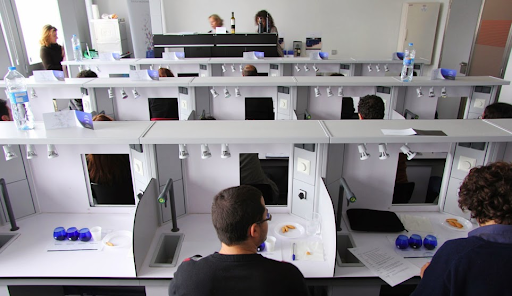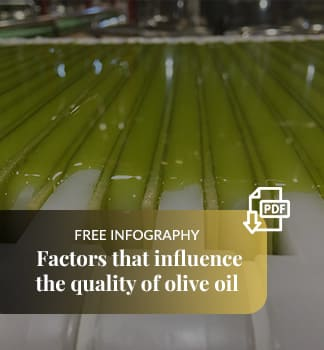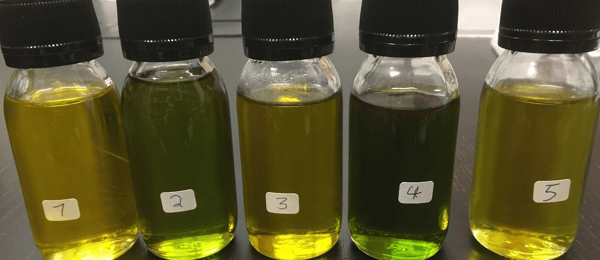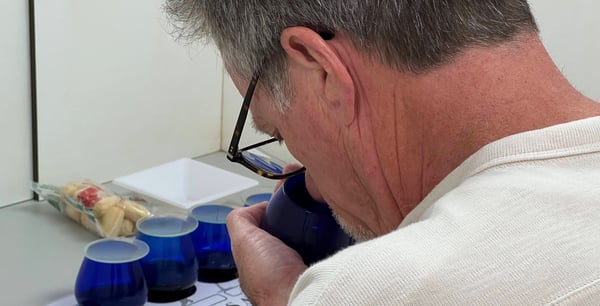Listen to this article
Different consumer organizations focus on their interventions related to Virgin Olive Oil (VOO). Sometimes they carry out random checks with unsatisfactory results.
In one of the last studies that we carried out at ESAO on samples sold in 8 supermarkets and large stores, internationally, we saw how the independent ESAO tasting panel classified as Virgin Olive Oil, oils that were labeled as lampantes, even two of them were classified as lampantes, and yet the label specified that they were Extra Virgin Olive Oils (EVOO).
One of the reasons that facilitate this type of "errors" is the lack of consumer culture about the different categories of extra virgin olive oil, and, above all, the lack of knowledge about tasting and sensory analysis of virgin olive oil.
Tasting olive oil, knowing and knowing what is sensory analysis in virgin olive oil, is the first step to avoid these incorrect labels.
Olive oils in supermarket. ESAO Image Bank
60 years ago we had a similar lack of culture with wine. Other distilled beverages took center stage, and little by little the wine sector made an effort, with large investments in training and hiring of professionals, in improving technology and betting on international markets. Once this was done, quality began to come to the production of wines and in this way the consumer was learning and tasting increasingly higher quality wines.
Once “decent” wines reached mass consumption, wine tastings began to take center stage. And it is that when the consumer learns to differentiate some wines from others he can already request, comment and distinguish. Olive Oil is one more product where the same journey is taking place.
As we have said, what is necessary to know the quality of a Virgin Olive Oil and to know what we have to pay for it, is to differentiate some virgin olive oils from others. For consumers to know about Extra Virgin Olive Oil and acquire this culture, the only way is to offer people the opportunity to taste and compare them with each other, and, in this way, get to know each other.
Making Extra Virgin Olive Oil is an activity that must be accompanied by your offering and your invitation to the tasting. This formula, whether it looks interesting or not, is the simplest form of marketing. To the extent that the consumer understands sensory analysis, he will be able to distinguish some virgin olive oils from others and will naturally select the highest quality ones.

ESAO students in Tasting. ESAO Image Bank
Having seen the importance of sensory analysis in an olive oil tasting, we are going to see what that sensory analysis or organoleptic analysis consists of in a virgin olive oil tasting.
Sensory analysis
Sensory analysis is the examination of the organoleptic properties of a product that can be performed with the human senses.
In the sensory analysis of Virgin Olive Oil, an attempt is made to isolate the sensory or organoleptic properties and then proceed to their classification according to the regulations established in this regard, in this case by the International Olive Council (IOC). In Virgin Olive Oil, the sensory analysis is the evaluation of the aroma and flavor of the virgin olive oil.
Although the level of uncertainty of the sensory analysis is greater than that of the technological systems, to date it is the only one authorized for the classification of virgin olive oils. The only sensory method for virgin olive oil is sensory analysis through the panel test tool, carried out by an official tasting panel.
The complexity and richness of nuances present in the aroma, color and flavor of Virgin Olive Oil is inherent in its composition as well as in its production procedure. This is what distinguishes it from any other vegetable oil.
Virgin olive oil can be consumed directly as if it were a natural fruit juice, and this makes it a product with remarkable nutritional and organoleptic characteristics. When we talk about sensory analysis in AOV, we have to refer to flavor. By flavor we understand the set of perceptions of gustatory, tactile and kinesthetic olfactory stimuli that allows a subject to identify a food and establish a criterion, at different levels of liking or disliking.
In Virgin Olive Oil, the organs that will be used to perform the sensory analysis will be the nose and mouth, working on aroma and taste respectively.
Taste
It is located in the oral cavity. Especially on the tongue and on the surface are located the main perceptions. The palate, the inner lateral pillars of the throat and the posterior wall of the throat are also sensitive to flavors.
Image of ESAO students working on the sense of taste. ESAO image bank
We find two of the fundamental flavors that we will work on in the sensory analysis of Extra Virgin Olive Oil, and these are bitter and spicy. These two flavors (despite the fact that spiciness is not strictly a flavor but a kinesthetic sensation) are what we call positive attributes of virgin olive oil.
Bitter flavors are noticeable on the back of the tongue, it is slow to develop, but increases and lasts longer.
The spicy stimulus is also perceived in almost the entire tongue, preferably in the throat.
To make a good tasting of the fundamental flavors, olive oil must reach the entire sensitive oral surface, that is, from the tip of the tongue to the back of the palate.
The phenolic compounds in Virgin Olive Oil will stimulate the taste receptors, causing the perception of bitterness and the endings of the trigeminal nerve, endings involved in the perception of spicy, astringent and metallic notes in the oils.
The sense of smell
The aroma in Virgin Olive Oil is perceived as a result of the interaction between numerous volatile compounds and their corresponding olfactory receptors, in general the aroma will be the dominant perception of any food.
Image of ESAO students working on their sense of smell. ESAO image bank
The characteristic aroma of OOV is the result of a complex mixture of volatile compounds that mainly includes aldehydes, alcohols, ketones, hydrocarbons, furans and esters. However, the first two represent qualitatively and quantitatively the most important fractions of volatile compounds in Virgin Olive Oil.
These compounds are responsible for the green aromatic notes characteristic of Virgin Olive Oil. The volatile compound profile of an oil differs depending on its quality, this profile being more complex as its quality is lower.
In other words, freshly obtained, high-quality Virgin Olive Oil has a simpler volatile compound profile than low-quality ones that present a greater number of volatile compounds responsible for unpleasant odors and that come from different enzymatic and chemical routes.
The quality of the oil, the variety and the degree of maturation of the olive will be great determinants of the volatile fraction of the virgin olive oil.
Purpose of sensory analysis
The objective of sensory analysis in olive oil is to detect defects and to be able to know what quality of oil we are in front of, since even if they teach us a physicochemical analysis or see the labeling of the bottle, today they are not enough tools to detect if we are dealing with a quality Virgin Olive Oil.
On the other hand, and just as important as the above is that, without sensory analysis, we would not be able to pair the olive oils. We must not forget that virgin olive oil is used in restaurants today. This means that it is always accompanied by food. Thanks to the sensory analysis we can determine with which food or foods we would like to use one oil or another more. Once we enter the olive culture and know how to distinguish between the different qualities, we will also proceed to differentiate the characteristics of the different varieties of olives, and in this way we will be able to increase our possibilities in the kitchen.
ESAO tasting session. ESAO image bank
Sensory analysis and tasting, today is the one that will tell us and determine which olive oil we are facing, what is its fair price and with which foods it will be best paired with.
This article aims to answer why sensory analysis is important in a virgin olive oil tasting, but it is not the place to delve into each of the points.
For in-depth knowledge of everything related to sensory analysis and extra virgin olive oil tasting, you have access to the ESAO training campus where all the details of this discipline will be analyzed.
.png)





